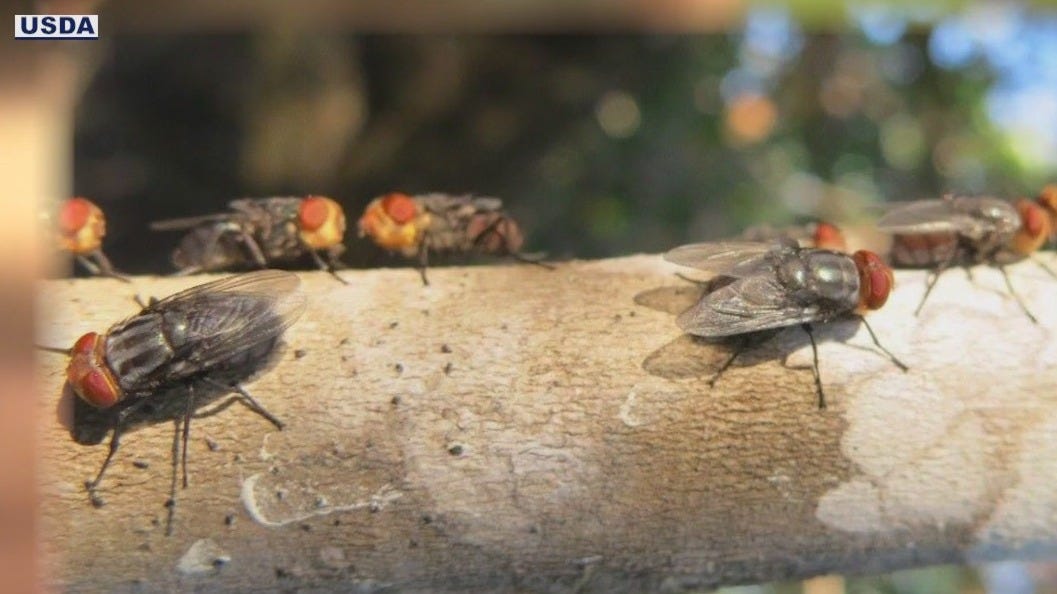How dangerous is the New World Screwworm? In rare cases, its maggots will eat your flesh
The U.S. has blocked imports of live cattle, horses, and bison through southern border ports following the resurgence in Mexico of the New World Screwworm, a parasitic fly that infects animals and threatens humans.
New World screwworm flies cause myiasis, an infection of flesh-eating maggots that burrow into the skin of living animals, causing serious and often fatal damage, Reuters reported.
The fly is named for how its maggots burrow, or screw, into an open wound using "its sharp mouth hooks," according to the Animal and Plant Health Inspection Service.
NWS has recently been detected “in remote farms with minimal cattle movement as far north as Oaxaca and Veracruz, about 700 miles away from the U.S. border,” the U.S. Department of Agriculture said in announcing the ban on Sunday.
New World Screwworm began resurgence in Central America
Unable to view our graphics? Click here to see them.
The parasites can infect livestock, wildlife, birds, pets, and, in some rare cases humans, the USDA says. The ban, which affects animals coming from and through Mexico, will continue on a month-by-month basis until the threat is contained, the department said.
NWS was eradicated in the U.S. in the 1960s, in Mexico in the 1970s, and much of Central America in the early 2000s, according to the Centers for Disease Control and Prevention.
However, new cases were reported in October 2024 in Panama, Costa Rica, Nicaragua, and Honduras, the CDC said. That sparked concern that the insects would spread north to the United States.
The first case in southern Mexico was reported to the United States in November, the USDA said.
While the United States and Mexico continue to work together to eradicate NWS in Mexico, “there has been unacceptable northward advancement of NWS and additional action must be taken to slow the northern progression of this deadly parasitic fly,” the USDA said.
What's so dangerous about the NWS?
NWS flies, about the size of a common housefly, lay eggs “on open wounds or other open parts of the body in live, warm-blooded animals,” according to the CDC. A wound as small as a tick bite can attract the flies.
The eggs hatch and become larvae, or maggots. They burrow into the wound to feed on the living flesh, the CDC says. That’s different from most other types of maggots that feed on decomposing flesh.
After they feed, the larvae fall to the ground and burrow into it. They later emerge as adult screwworm flies, the CDC says.
As you might expect, burrowing maggots in living creatures are highly painful.

What are the symptoms of NWS infection in humans?
NWS infestations are very painful, the USDA says. If you have an infestation, you may see maggots around or in an open wound, or your nose, eyes, or mouth. Symptoms can include:
◾Unexplained skin lesions (wounds or sores) that do not heal.
◾Skin wounds or sores that worsen over time.
◾Painful skin wounds or sores.
◾Bleeding from open sores.
◾Feeling larvae movement within a skin wound or sore, nose, mouth, or eyes.
◾Seeing maggots around or in open sores.
◾A foul-smelling odor from the site of the infestation.
A secondary bacterial infections sometimes occur and may cause fever or chills.
In animals, the symptoms include:
◾Irritated behavior.
◾Head shaking.
◾Smell of decay.
◾Evidence of a fly strike.
◾Presence of fly maggots in wounds.
What should you do if you get infected?
Maggots in a wound or a body part need to be removed by a medical professional, the CDC says. Don’t try to remove them yourself.
CONTRIBUTING Greta Cross, John Bacon, Mike Snider
SOURCE Paste BN Network reporting and research; Reuters; Department of Agriculture; Centers for Disease Control and Prevention
This story was updated to add new information.